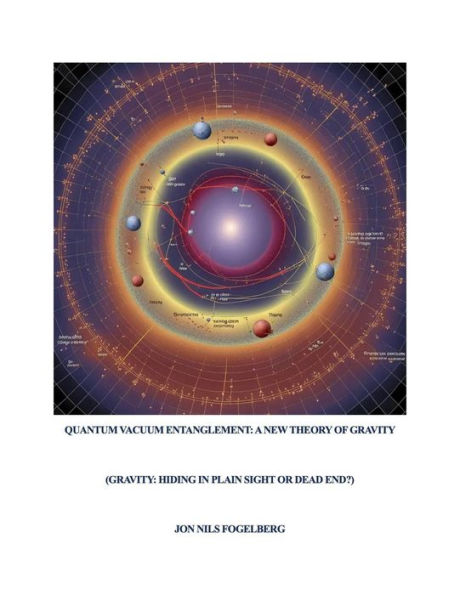In "Quantum Vacuum Entanglement: A New Theory of Gravity," readers embark on a groundbreaking journey beyond the frontiers of contemporary physics, exploring a revolutionary hypothesis that reimagines the fundamental nature of gravity.
For centuries, gravity has been understood as the invisible force that binds the cosmos, from the fall of an apple to the orbit of distant planets. Traditional theories, from Newton's laws to Einstein's General Relativity, have framed gravity as a curvature of spacetime or an innate attraction between masses. However, what if our understanding of this cosmic glue has only scratched the surface?
This compelling book introduces the "Quantum Vacuum Entanglement Theory of Gravity," a daring hypothesis proposing that gravity emerges not as a fundamental force, but as a manifestation of quantum entanglements permeating the vacuum of space. Drawing on the mysteries of quantum mechanics and the expansive canvas of cosmology, the theory suggests that gravity is a byproduct of the nonlocal correlations among foundational quantum units – gravitons, birthed in the extreme conditions following the Big Bang.
Through engaging narrative and accessible explanations, the book delves into how these entangled gravitons create a dynamic flux, which, at the macroscopic scale, mimics gravitational attraction. It challenges readers to rethink the gravitational pull that keeps galaxies bound and light curved, presenting it as an integrated dance of microscopic vacuum alterations.
The book does not just theorize; it connects these speculative ideas with observable phenomena, from the stable rotation of galaxies to the subtle nuances in planetary orbits. It boldly ventures into the realm of unification, seeking to align gravity with other fundamental forces, and paints a picture of a holographic, probabilistic cosmos, where the very fabric of reality is woven with quantum threads.
"Quantum Vacuum Entanglement: A New Theory of Gravity" is not merely a presentation of a new scientific idea; it is an invitation to witness the potential dawn of a new era in physics. It's a must-read for anyone fascinated by the mysteries of the universe, from avid science enthusiasts to professional physicists, offering a fresh perspective on one of the most fundamental forces of nature. This book promises to ignite discussions, spark debates, and inspire a reimagined understanding of the cosmos.
In "Quantum Vacuum Entanglement: A New Theory of Gravity," readers embark on a groundbreaking journey beyond the frontiers of contemporary physics, exploring a revolutionary hypothesis that reimagines the fundamental nature of gravity.
For centuries, gravity has been understood as the invisible force that binds the cosmos, from the fall of an apple to the orbit of distant planets. Traditional theories, from Newton's laws to Einstein's General Relativity, have framed gravity as a curvature of spacetime or an innate attraction between masses. However, what if our understanding of this cosmic glue has only scratched the surface?
This compelling book introduces the "Quantum Vacuum Entanglement Theory of Gravity," a daring hypothesis proposing that gravity emerges not as a fundamental force, but as a manifestation of quantum entanglements permeating the vacuum of space. Drawing on the mysteries of quantum mechanics and the expansive canvas of cosmology, the theory suggests that gravity is a byproduct of the nonlocal correlations among foundational quantum units – gravitons, birthed in the extreme conditions following the Big Bang.
Through engaging narrative and accessible explanations, the book delves into how these entangled gravitons create a dynamic flux, which, at the macroscopic scale, mimics gravitational attraction. It challenges readers to rethink the gravitational pull that keeps galaxies bound and light curved, presenting it as an integrated dance of microscopic vacuum alterations.
The book does not just theorize; it connects these speculative ideas with observable phenomena, from the stable rotation of galaxies to the subtle nuances in planetary orbits. It boldly ventures into the realm of unification, seeking to align gravity with other fundamental forces, and paints a picture of a holographic, probabilistic cosmos, where the very fabric of reality is woven with quantum threads.
"Quantum Vacuum Entanglement: A New Theory of Gravity" is not merely a presentation of a new scientific idea; it is an invitation to witness the potential dawn of a new era in physics. It's a must-read for anyone fascinated by the mysteries of the universe, from avid science enthusiasts to professional physicists, offering a fresh perspective on one of the most fundamental forces of nature. This book promises to ignite discussions, spark debates, and inspire a reimagined understanding of the cosmos.

Quantum Vacuum Entanglement: A New Theory of Gravity

Quantum Vacuum Entanglement: A New Theory of Gravity

Product Details
| BN ID: | 2940179383864 |
|---|---|
| Publisher: | Jon Nils Fogelberg |
| Publication date: | 12/07/2023 |
| Sold by: | Draft2Digital |
| Format: | eBook |
| File size: | 8 MB |
